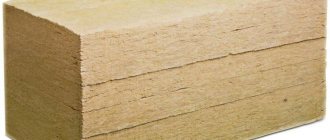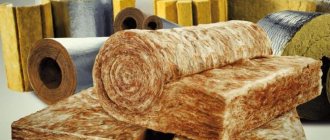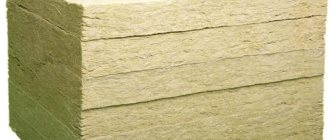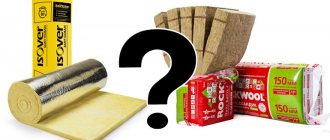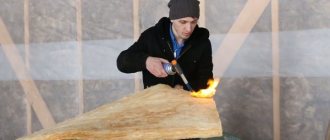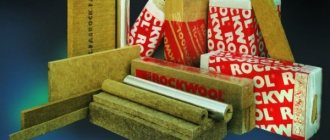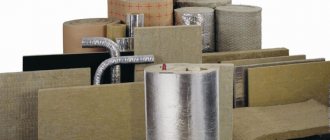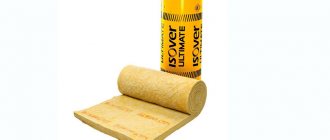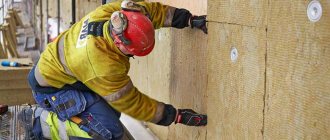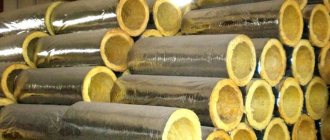The construction of a private house is almost always accompanied by finishing of the facade. For this, various building materials are used, but due to ease of installation and accessibility, the choice often falls on siding. This type of finishing coating cannot serve as a thermal insulation layer, so a house that is planned to be covered with siding needs wall insulation. In this article we will look at what types are suitable for thermal insulation, what is the density of mineral wool for siding and how to install the insulation yourself.
Siding finishing
What is mineral wool
Mineral wool is an insulation material that has a fibrous base and is of inorganic origin. This determines its high thermal insulation properties. Depending on the material used for the production of mineral wool, the fiber structure differs:
- Horizontally layered.
- Vertically layered.
- Corrugated.
- Spatial.
This diversity allows you to expand the scope of application of mineral wool products.
The resistance of the fiber to high temperatures indicates the possibility of using flammable coatings for insulation. Interior partitions assembled using mineral insulation have excellent sound-proofing and heat-insulating qualities.
Manufacturers produce a large amount of fiber-containing material, which is widely used in the construction and repair of construction projects. The main areas of application are the thermal insulation of walls and attic floors. Considering work on production sites, a use for wool has been found in insulating high-temperature surfaces. This category includes furnaces, pipelines, heating mains and other equipment.
Manufacturers
It is better to buy cotton wool from trusted manufacturers. Among them are both well-known brands and mineral wool brands that are unfamiliar to the mass consumer.
Rockwool. (Denmark) produces insulation from basalt and gabbro fibers at production facilities located in several countries, including Russia. Features of insulating mats are:
- low thermal conductivity;
- good absorption of air noise;
- resistance to open flame (flammability class NG);
- long service life;
- environmental cleanliness.
Paroc. A manufacturer of basalt wool from Finland () offers consumers mats for residential construction and acoustic insulation of recording studios.
The insulation is characterized by a low thermal conductivity coefficient, fire resistance, and durability. It is almost impossible to find counterfeit products on sale - the company very carefully monitors the market for counterfeits. Unfortunately, for the average consumer the price of insulation is too high.
Isover. The leader in sales of mineral wool in Europe is a transnational company registered in France, which has its production facilities in Russia. The product has the best balance between price and quality.
TechnoNIKOL. The brand of thermal and waterproofing materials "TechnoNIKOL" belongs to Russian business, but is produced in many European countries (Lithuania, Belarus, Czech Republic, England). Among the huge product line, mineral wool insulation occupies a significant place. Modern equipment and careful quality control allowed the company to enter the TOP 5 largest suppliers of mineral wool to the construction market of Europe and the CIS countries.
IZOVOL. produces basalt insulation in Russia. The product has an affordable price and good quality. The line of insulation products includes mats produced separately for facades, roofs, floors, and foundations.
All quality characteristics meet the requirements of EU and Russian standards. A slight shedding of fibers during the installation process blurs the impression of quality. The manufacturer knows about the problem, but cannot fix it yet.
In addition to the listed brands, it is worth paying attention to the products of the brands “KNAUF” and “URSA”. It is very often bought for insulating timber houses.
From the middle price sector, experts note the insulation "Beltep" (Belarus). It has excellent rigidity, good vapor permeability, easy installation, and an affordable price.
Types of mineral wool
Manufacturers produce the following types of mineral insulation materials, which differ from each other in technical characteristics:
- Glass wool. The basis of fiberglass is glass, sand, lime and chemicals. Due to the high content of formaldehyde, use in insulating buildings is not recommended.
Important! All work with glass wool is carried out in special clothing that protects the skin from accidental cuts. Other personal protective equipment is also used: respirators, boots and goggles.
It consists of fibers whose thickness is from 5 to 15 microns with a length of 15-50 mm. Temperature range of use – from -60оС to +450оС. Conclusion: glass wool is not suitable for insulating the facade of a building under siding.
Glass wool
- Slag-like. Metallurgical production leaves behind a lot of waste, which was used in the manufacture of slag insulation. Blast furnace slag has residual acidity and this is the reason for the undesirable use of slag wool when insulating metal surfaces. In addition, the hygroscopicity of slag wool indicates the need to use waterproofing coatings. Fiber thickness is 4-12 microns with a length of up to 16 mm. Temperature range of use – from -50оС to +300оС. Conclusion: slag wool is not suitable for thermal insulation of walls under siding.
Slag
- Stone wool. It is devoid of the disadvantages that slag and glass wool have: fragility, low tensile strength, shrinkage after a short period of use, low temperature range of use. Fiber thickness is 5-12 microns with a length of up to 16 mm. Conclusion: suitable for insulating walls under siding.
Stone wool
- Basalt wool. Just like stone wool, it is made using diabase and gabbro. The absence of mineral binding additives increases the temperature range of use – from -190°C to +1000°C. Basalt is resistant to fire and therefore is used for insulation near high-temperature objects to insulate flammable structures. Fiber thickness is 5-15 microns with a length of 20-50 mm.
Basalt
Complete solution
One of the effective methods of insulation is the use of ready-made thermal panels. The heat-insulating layer of the panels is formed by polystyrene foam or polyurethane foam, and panels of smaller thickness are made from polyurethane foam, the insulating layer does not exceed 40 mm.
There are many product options, but to complement the finished house design you need to select:
- The smallest thickness;
- The most inexpensive option for the substrate, the back side of the panel;
- The easiest and most acceptable option for outdoor decoration of products;
- Favorable price.
Positive and negative sides of mineral wool
The advantages inherent in mineral insulation, regardless of the type and its initial characteristics:
- Ease of installation. Even an inexperienced builder can handle the work of insulating walls under siding. It is enough to have minimal skills.
- Minimal shrinkage. During operation, the material shrinks by a maximum of 1-5%. The type of fiber and density of arrangement determines how much it shrinks.
- Resistance to substances of chemical and biological origin.
- Fire resistance. In case of accidental fires, cotton wool can withstand open fire for some time, usually sufficient to extinguish the fire.
- Low level of hygroscopicity. This parameter applies to basalt and stone wool.
- High level of vapor permeability. Thanks to this advantage, the service life of the product is significantly increased.
- Soundproofing. The use of mineral wool when installing interior partitions relieves owners from loud sounds.
- Environmental friendliness. Manufactured from natural ingredients, it can be used without worrying about human health. This does not apply to fiberglass insulation.
- Long operational period. If installation standards and requirements for the use of the material are observed, mineral wool retains its original qualities for 70-80 years.
Disadvantages inherent exclusively to glass wool and slag wool:
- Fragility. The fragility of fiberglass makes working with this type of insulation difficult. It is for this reason that, according to safety regulations, it is not allowed to work with glass wool without a protective set of clothing.
- Formaldehyde. The resins that make up fiberglass-based mineral wool, when exposed to high temperatures, oxidize turning into phenol.
Attention! Phenol is a substance belonging to the class of highly hazardous. If it comes into contact with the mucous membrane, it causes burns. Working indoors with this substance without respiratory and eye protection is strictly prohibited.
- The need to install wind protection. Over time, the fiber insulation is blown away by wind currents. Therefore, when insulating walls under siding, it is necessary to create a protective barrier against drafts. Installing a conventional vapor barrier will help solve this problem.
Characteristics of blow-in insulation
Ecowool is a new material made from cellulose fibers. It contains a binder - lignin, fire retardants and boric acid as an antiseptic. Ecowool is a loose mass that is applied dry or “wet” method.
Ecowool
Penoizol and polyurethane foam have a cellular structure and are applied to walls in liquid form. They are light in weight, so they exert almost no load on the base, but at the same time cover the entire area with a dense, uniform layer. With this method of insulation there is no need to level the walls and install wind protection, which greatly simplifies installation.
Urea-formaldehyde foam - universal insulation
Insulating a house with foam insulation
Pros:
- absence of cold bridges;
- durability;
- low thermal conductivity;
- speed of installation.
Minuses:
- these materials are more expensive than other insulation materials;
- For application it is necessary to have special expensive equipment and experience working with it.
Thermal insulation with polyurethane foam
| Options | Ecowool | Penoizol |
| Thermal conductivity | from 0.037 to 0.042 W/(m*K) | from 0.031 to 0.041 W/(m*K) |
| Layer density | 28-65 kg/m3 | 5-75 kg/m3 |
| Vapor permeability | 0.3 mg/(mhPa) | 0.21–0.24 mg/(mhPa) |
| Flammability degree | G2 | G1 |
| Working temperature | from -40 to +120 0С | -60 + 80 ᵒС |
Density of mineral wool for insulating walls under siding
The density of mineral wool is reflected in the performance characteristics. Thus, mineral slabs are distinguished by a denser arrangement of fibers, and therefore are more popular among developers of private housing.
Due to the dense arrangement of fibers, some parameters of mineral wool are increased:
- Strength. Dense accumulation of fibers allows you to withstand heavy loads.
- Moisture resistance. Reducing the size of the free space between individual particles prevents large water particles from seeping through the thickness of the material.
- Fire resistance. Dense types of mineral wool are much more resistant to fire and can withstand prolonged exposure to open fire.
- Shrinkage. The percentage of material shrinkage is reduced, because during the manufacturing process, the slabs undergo a pressing process.
Size range of mineral wool slabs:
- Length – from 100 to 600 cm.
- Width – from 20 to 180 cm.
- Thickness from 2 to 25 cm.
The size differs depending on the type of thermal insulation material based on mineral fibers.
Frame details
The external insulation frame is mounted from vertical guide elements. To do this, use a metal profile or wooden beam. In the first option, there is a possibility of parts freezing, the presence of cold bridges, condensation accumulation with further destruction of insulation elements.
Packing cotton wool tightly into the grooves will prevent negative consequences. When fastening, direct hangers are used; they allow you to adjust the installation depth. A thin metal profile is less rigid than timber.
The insulation frame is assembled from guide elements.
Wooden guides are more durable and resistant to temperature fluctuations, but are labor-intensive to install.
Due to the heterogeneity of the structure (cracks, knots, etc.) they require careful selection and processing. May change shape during storage.
Vapor barrier of walls
Vapor barrier is a layer of roll or mastic type material aimed at creating an obstacle to the passage of atmospheric or operational water vapor. Building materials have different levels of vapor barrier. So for wood these indicators are 0.03, and for mineral wool – 0.06. But there are materials that do not allow moisture to pass through at all - iron and glass.
Based on the available indicators, you can roughly understand how densely a particular material is filled with moisture. When the insulation is oversaturated with moisture, some of the thermal insulation characteristics are reduced.
To prevent such a drawback, a vapor barrier layer is installed. The lack of vapor barrier leads to the destruction of the building and the thermal insulation material.
Let's look at the process using an example:
- Heating a room from the inside leads to warming up of the walls.
- From the outside of the building, warmth meets cold air currents.
- The point where the warm and cold flow collide is called the dew point. This place is characterized by the accumulation of condensation.
- As a result of constant dampness, fungus forms on the walls, eating into the surface and having a destructive effect.
When installing a vapor barrier, you need to know that the film is attached with an overlap of 10-15 cm on each other. Then, the joint is taped with stationery tape.
Vapor barrier for siding
How to lath under mineral wool on the outside of a wall
When starting to install the sheathing, you need to perform a number of actions:
- Dismantle the old covering and sheathing, if any.
- Clean the surface from debris and dust.
- If bulges, cracks or gouges are found, take measures to eliminate these deficiencies.
- Treat the timber for the sheathing with a fire-resistant primer and antiseptic material.
To fasten wooden guides, use metal brackets and dowel plugs. Depending on the width of the prepared insulation boards, the pitch between the beams is set. Don't forget to leave an allowance of 2-3 cm on each side. This will allow the mats to be securely fixed between the wooden guides.
The method of placing the sheathing is determined by the type of siding arrangement when covering the facade of the building. When installing the frame, periodically check the level position of the beam in the plane. A building level is used as an auxiliary tool.
Traditional approach
In cases where it is undesirable to overload the facade due to the small safety margin of the house, it is necessary to dismantle the outer part to add insulation.
Disassembly
Careful actions during disassembly will help avoid additional costs:
- First, the exterior trim is removed;
- The base is dismantled;
- The counter-lattice is disassembled;
- The wind protection is removed.
- After adding the insulating layer, the restoration of the facade occurs in the reverse order.
Adding insulation
When access to the frame racks is free, a visual inspection of the frame filled with insulation is carried out. If construction defects or negative changes have been detected over the past period of operation, measures must be taken to restore the integrity of the insulation.
Perhaps these will be separate, not very significant, cracks in the junctions of the insulation and studs, or an increased gap between the insulation boards due to shrinkage - they must be carefully treated with polyurethane foam.
After this, beams equal in thickness to the insulation are sewn to the frame racks. As a rule, this is a 50 X 50 beam, for using basalt slabs of the same thickness. The technology is similar to the initial structure of the frame, the main thing in which is the absence of cracks and gaps. The façade is then restored to its pre-disassembly state.
If the facade was dismantled carefully and accurately, then some of the materials can be installed back. But practice shows that it is better to use new materials to restore the facade, and use the removed ones in less critical structures.
Technology of insulating walls outside with mineral wool under siding
Technological process of laying thermal insulation material under siding:
- The prepared wall surface is treated with a primer mixture. To increase adhesion.
- Next, the sheathing is attached. Think in advance about how to position the guides - horizontally or vertically.
- Vapor barrier is installed. The stripes overlap each other.
- The insulation is being cut. The operation is performed using a stationery knife. Sheets should be with a small margin.
- Laying insulation. Pressing the sides of the mineral wool a little, we place it in its permanent place.
- Additional vapor barrier. A vapor barrier layer is stretched over the sheathing and insulation sheets.
- Fixing the second sheathing. It is necessary for fastening siding panels. For vinyl type, the spacing between sheathing panels is 400 mm. For the metal type of siding, the pitch increases to 600-1000 mm.
Insulation under siding
Video description
Why it is important for vinyl siding to make smaller strut pitches, see the video below:
See also: Catalog of house projects using frame technology presented at the “Low-Rise Country” exhibition.
Frame around the window Source viteko.ucoz.ru
But there is one subtlety here. If the wall structure does not have windows and doors, then markings are applied from any corner to the opposite one with the step indicated above. If windows and doors are present, then markings are carried out from their edges. That is, frame posts must be present at the edges of the mounting openings. Therefore, in these places vertical lines are drawn along the walls. And then lines are laid from them to the right and left in increments of 0.4-1 m.
The rack profile is attached to the walls of a wooden house using direct hangers. The latter are installed along the marked lines in increments of 0.5-1 m. Wood screws are used for fastening.

